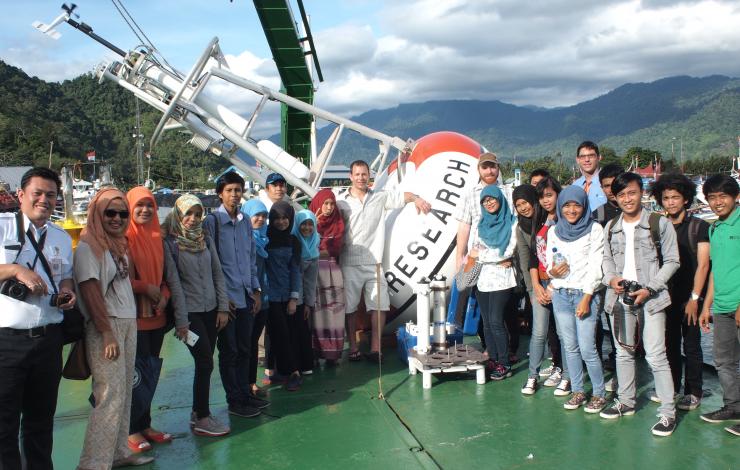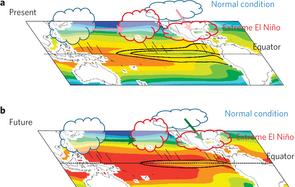What's New Archive
PMEL Tropical Moored Buoy Array technicians Patrick Berk and Bill Higley recently completed a collaborative RAMA cruise aboard Indonesian Research Vessel Baruna Jaya 1. While in Indonesia, they participated in formal ceremonies celebrating the pending bilateral agreement between PMEL and Indonesia's meteorology and climatology agency, BMKG. This cruise marked a new phase of U.S. – Indonesian cooperation to better understand ocean-climate variability and how it affects the planet, and builds on years of cooperation between the two countries.
The RAMA array of surface and subsurface moorings in the Indian Ocean complements NOAA’s tropical moored arrays in the Atlantic Ocean, the Prediction and Research Moored Array in the Tropical Atlantic (PIRATA), and in Pacific Ocean, the Tropical Atmosphere Ocean (TAO) array, and Japans Triangle Trans-Ocean Buoy Network (TRITON). RAMA will improve description, understanding, and prediction of Asian monsoons, which affect one third of the world’s population. Learn more about the Global Tropical Moored Buoy Array group.
An El Niño in the equatorial Pacific is expected to play a dominant role in the winter weather for the U.S. Temperatures are expected to be warmer than average across most of the western and central U.S. with cooler than average temperatures in the Southeast and mid-Atlantic states.
For more information on how PMEL helps detect El Niños please visit the NOAA El Niño web site.
PMEL would like to congratulate Dr. Michael McPhaden for being awarded the European Geosciences Union 2010 Fridtjof Nansen Medal. This prestigious award in ocean sciences was given to Dr. McPhaden for his leadership in developing ocean observing systems for climate research and forecasting and for fundamental contributions to our understanding of the ocean’s role in climate.
Please visit the Global Tropical Moored Buoy Array web page for more information on Dr. McPhaden’s research for which he received this medal.
PMEL senior scientist, Dr. Mike McPhaden is presiding over his first American Geophysical Union (AGU) meeting as AGU President. 2010 The Meeting of the Americas is being held in Iguassu Falls, Brazil during the week of August 9. Dr. McPhaden will lead a Town Hall meeting on "Communicating the Science of Climate Change".
Dr. McPhaden was elected President-elect of the AGU in 2008 and took over as President for a 2-year term beginning in 2010. He is the director of the Tropical Atmosphere Ocean project at PMEL.
In an article recently published in Geophysical Research Letters, Tong Lee of the Jet Propulsion Lab in Pasedena and Mike McPhaden of PMEL analyzed 30 years of NOAA satellite sea surface temperature data and found that the intensity of El Niño events in the central equatorial Pacific has almost doubled in the past three decades, with the strongest warming in 2009-10.
These “central Pacific” (CP) El Niño’s exhibit maximum warming in the central equatorial Pacific in contrast to the classical El Niños, which have maximum warming in the eastern equatorial Pacific.
PMEL staff are aboard two international vessels to recover and deploy moorings in the Indian Ocean as part of the Research Moored Array for African-Asian-Australian Monsoon Analysis and Prediction (RAMA) project. RAMA was initiated in 2004 to collect key oceanographic and meteorological data from the poorly observed Indian Ocean.
The establishment of one new site this month will mark the occupation of 30 sites, with a total of 46 sites planned for the entire array. For more information, please visit the RAMA web site.
PMEL technicians departed the week of January 7 for a 7-week cruise on the NOAA Ship Ronald H.Brown in the Northeast Atlantic to service moorings in the Prediction and Research Moored Array in the Atlantic (PIRATA). PMEL will be deploying 5 moorings at 4 PIRATA sites.
The PIRATA array was established in 1997 in partnership with France and Brazil and studies ocean-atmosphere interactions in the tropical Atlantic. Visit the PIRATA web page for more information.
For the first time, in a research article published January 19 in Nature Climate Change, PMEL’s Dr. Michael McPhaden and a team of international scientists provide robust and convincing evidence that greenhouse warming will double the chance of extreme El Niño events in the coming decades. The scientists examined 20 climate models and found a doubling of extreme El Niño events, like the one in 1997-98, from present-day through the next 100 years in response to greenhouse warming.
For more information on El Niño, please visit the Tropical Atmosphere Ocean project website.




